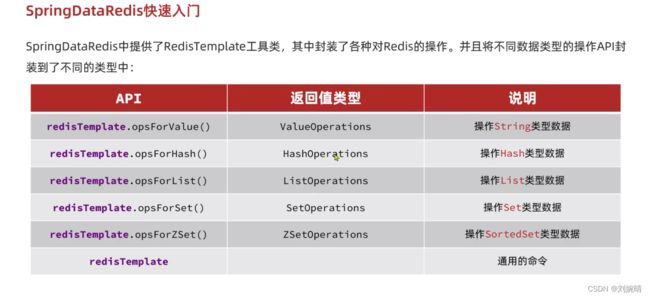【Redis】使用 Java 客户端连接 Redis
一、三种客户端比较
Jedis : 学习成本低,以 Redis 命令作为方法名称,但是其线程不安全
lettuce:基于 Netty 实现,支持同步、异步、响应式编程(SpringBoot),并且线程安全。支持 Redis 的哨兵模式、集群模式和管道模式。
Redisson: 基于 Redis 实现的分布式、可伸缩的 Java 数据结构集合。
二、Jedis 基础使用
- 引入依赖
<dependency>
<groupId>redis.clientsgroupId>
<artifactId>jedisartifactId>
<version>4.3.1version>
dependency>
- 使用单元测试进行测试
package com.example.redis;
import lombok.Data;
import org.junit.jupiter.api.BeforeEach;
import org.junit.jupiter.api.Test;
import org.springframework.boot.test.context.SpringBootTest;
import redis.clients.jedis.Jedis;
@SpringBootTest
class RedisApplicationTests {
private Jedis jedis;
@BeforeEach
void setUp(){
jedis = new Jedis("192.168.33.10", 6379); // new 一个 jedis 对象
jedis.select(0);
}
@Test
void contextLoads() {
jedis.set("testJedis", "存入成功");
String haha = jedis.get("testJedis");
System.out.printf(haha);
}
}
三、SpringDataRedis
1. SpringDataRedis 基础概况
1)导入依赖
<dependency>
<groupId>org.springframework.bootgroupId>
<artifactId>spring-boot-starter-data-redisartifactId>
dependency>
<dependency>
<groupId>org.apache.commonsgroupId>
<artifactId>commons-pool2artifactId>
<version>2.11.1version>
dependency>
2)编写配置文件
spring:
redis:
host: 192.168.33.10 # 你的 redis 地址
#数据库索引
database: 0
port: 6379
#password:
#连接超时时间(ms)
timeout: 5000
# 自定义redis默认过期时间(单位:时)
expire-time: 24
jedis:
pool:
# 连接池最大连接数(使用负值表示没有限制)
max-active: -1
# 连接池最大阻塞等待时间(使用负值表示没有限制)
max-wait: -1
3) 测试连接
package com.example.redis;
import lombok.Data;
import org.junit.jupiter.api.BeforeEach;
import org.junit.jupiter.api.Test;
import org.springframework.beans.factory.annotation.Autowired;
import org.springframework.boot.test.context.SpringBootTest;
import org.springframework.data.redis.core.RedisTemplate;
import redis.clients.jedis.Jedis;
@SpringBootTest
class RedisApplicationTests {
@Autowired //自动注入即可
private RedisTemplate redisTemplate;
@Test
void contextLoads() {
redisTemplate.opsForValue().set("testRedisTemplate", "测试成功");
redisTemplate.opsForValue().get("testRedisTemplate");
}
}
4) 对象类型序列化存储
———— 方式一:
redisTemplate 的 key 和 value 都是对象类型。key 和 value 会先被序列化,然后存储 ,若是自己不定义序列化方式,会用默认的 jdk 的序列化器 。这种方式序列化出来的 key 和 value 往往是读不友好的,因此我们要自定义序列化方式。
在具体实现时,我们将 key 固定为 String 类型 ( key 一般情况都是 String 类型),将 Value 固定为 Object 类型,key 使用 RedisSerializer.string() 方式序列化,value 使用 GenericJackson2JsonRedisSerializer 序列化器序列化。
- 为容器中注入一配置类设置 RedisTemplate序列化方式:
package com.example.redis.config;
import org.springframework.context.annotation.Bean;
import org.springframework.context.annotation.Configuration;
import org.springframework.data.redis.connection.RedisConnectionFactory;
import org.springframework.data.redis.core.RedisTemplate;
import org.springframework.data.redis.serializer.GenericJackson2JsonRedisSerializer;
import org.springframework.data.redis.serializer.RedisSerializer;
@Configuration
public class RedisConfig {
@Bean
public RedisTemplate<String, Object> redisTemplate(RedisConnectionFactory redisConnectionFactory){
// 创建 RedisTemplate 对象
RedisTemplate<String, Object> redisTemplate = new RedisTemplate<>();
// 设置连接工厂
redisTemplate.setConnectionFactory(redisConnectionFactory);
// 创建 JSON 序列化工具
GenericJackson2JsonRedisSerializer genericJackson2JsonRedisSerializer = new GenericJackson2JsonRedisSerializer();
// 设置 key 的序列化 (用 String 类型的序列化)
redisTemplate.setKeySerializer(RedisSerializer.string());
redisTemplate.setHashKeySerializer(RedisSerializer.string());
// 设置 value 的序列化 (用 jack 类型的序列化)
redisTemplate.setValueSerializer(genericJackson2JsonRedisSerializer);
redisTemplate.setHashKeySerializer(genericJackson2JsonRedisSerializer);
return redisTemplate;
}
}
- 存储读取对象测试:
// City 对象
package com.example.redis.bean;
import lombok.Data;
import java.io.Serializable;
@Data
public class City implements Serializable {
private int id;
private String name;
private String countryCode;
private String district;
private String population;
}
// 测试类
@Autowired
private RedisTemplate<String, Object> redisTemplate;
@Test
void contextLoads() {
City city = new City();
city.setId(1);
city.setName("沈阳");
city.setPopulation("10000");
city.setDistrict("haha");
city.setCountryCode("中国");
redisTemplate.opsForValue().set("city:1", city);
City c = (City) redisTemplate.opsForValue().get("city:1");
System.out.printf("*********************************************" + c + "************************************");
}
结果截图:
———— 方式二:
GenericJackson2JsonRedisSerializer 的问题:
GenericJackson2JsonRedisSerializer 存储对象时夹带了私货 , @class 占用了额外内存空间,但是但是不加 @class 就不能自动反序列化,因此我们提出方式二。
解决 GenericJackson2JsonRedisSerializer 空间占用问题:
存储对象时对对象进行 手动序列化 和 反序列化,具体实现时,使用SpringMVC 提供的 ObjectMapper 类的 writeValueAsString 和 readValue 方法对对象进行序列化和反序列化。
示例代码如下:
import com.example.redis.bean.City;
import com.fasterxml.jackson.core.JsonProcessingException;
import com.fasterxml.jackson.databind.ObjectMapper;
import org.junit.jupiter.api.Test;
import org.springframework.beans.factory.annotation.Autowired;
import org.springframework.boot.test.context.SpringBootTest;
import org.springframework.data.redis.core.RedisTemplate;
import org.springframework.data.redis.core.StringRedisTemplate;
@SpringBootTest
class RedisStringApplicationTests {
@Autowired
private StringRedisTemplate redisTemplate;
// SpringMVC 中手动序列化的工具
private static final ObjectMapper mapper = new ObjectMapper();
@Test
void contextLoads() throws JsonProcessingException {
// 创建对象
City city = new City();
city.setId(1);
city.setName("沈阳");
city.setPopulation("10000");
city.setDistrict("haha");
city.setCountryCode("中国");
// 手动序列化
String json = mapper.writeValueAsString(city);
// 写入数据
redisTemplate.opsForValue().set("city:2", json);
// 获取数据
String getCityJson = redisTemplate.opsForValue().get("city:2");
// 手动反序列化为对象
City c = mapper.readValue(getCityJson, City.class);
System.out.println("****************************" + c + "************************");
}
}
结果截图:
通过这种方式存储的对象数据就清清爽爽了
5) Hash 数据结构操作测试
@SpringBootTest
class RedisHashApplicationTests {
@Autowired
private StringRedisTemplate stringRedisTemplate;
@Test
void contextLoads() {
// 存数据
stringRedisTemplate.opsForHash().put("city:3", "id", "3");
stringRedisTemplate.opsForHash().put("city:3", "name", "北京");
// 取数据
Map<Object, Object> entries = stringRedisTemplate.opsForHash().entries("city:3");
System.out.printf("*********************************************" + entries);
}
}




